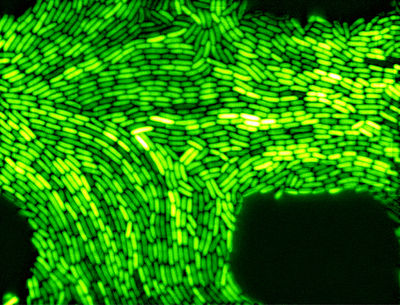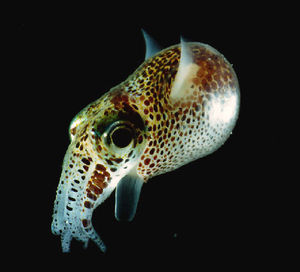Vibrio fischeri NEU2011: Difference between revisions
No edit summary |
No edit summary |
||
| Line 20: | Line 20: | ||
==Description and Significance== | ==Description and Significance== | ||
[[File:bobtail_squid.jpg|300px|thumb|right|]] | |||
Vibrio Fischeri is a member of the phylum proteobacteria. These bacteria are motile, gram-negative rods that are found in temperate and subtropical waters. These heterotrophic bacteria use flagella as a means of movement and they are most famous for their bioluminescence properties. V. Fischeri is mainly found living in symbiosis with various deep sea marine animals such as monocentrid fishes and bobtail squid. V. Fischeri is found within unique light-organs or as part of the normal gut of these marine animals (V. Fischeri). | Vibrio Fischeri is a member of the phylum proteobacteria. These bacteria are motile, gram-negative rods that are found in temperate and subtropical waters. These heterotrophic bacteria use flagella as a means of movement and they are most famous for their bioluminescence properties. V. Fischeri is mainly found living in symbiosis with various deep sea marine animals such as monocentrid fishes and bobtail squid. V. Fischeri is found within unique light-organs or as part of the normal gut of these marine animals (V. Fischeri). | ||
Revision as of 00:48, 25 February 2011
A page on the microorganism Vibrio fischeri
Classification
Higher order taxa
Vibrio fischeri
- Kingdom: Bacteria
- Phylum: Proteobacteria
- Class: Gamma Proteobacteria
- Order: Vibrionales
- Family: Vibrionaceae
- Genus: Vibrio
- Species: V. fischeri
Description and Significance
Vibrio Fischeri is a member of the phylum proteobacteria. These bacteria are motile, gram-negative rods that are found in temperate and subtropical waters. These heterotrophic bacteria use flagella as a means of movement and they are most famous for their bioluminescence properties. V. Fischeri is mainly found living in symbiosis with various deep sea marine animals such as monocentrid fishes and bobtail squid. V. Fischeri is found within unique light-organs or as part of the normal gut of these marine animals (V. Fischeri).
V. Fischeri can also be found living as free bacteria in small quantities surviving on decaying organic matter. V. Fischeri use proteins coded by a set of genes called the lux operon to produce bioluminescence. The light is produced in a chemical reaction where luciferin is oxidized by the enzyme luciferase. As a result of the oxidation, a blue-green light is emitted. The symbiotic relationship between a strain of the V. Fischeri and its host, the bobtail squid Euprymna scolopes, has been studied extensively. The bobtail squid acquires these bacteria from its surroundings and uses it as a protection from predators. Within several hours of being ingested, these bacteria begin to change. They decrease in size, lose their flagella, and begin to emit light. These bacteria help to eliminate the squid’s shadow caused by the moonlight above (Vibrio Fischeri). The isolation and cloning of the lux gene from V. Fischeri, and their use as a reporter gene, have provided scientists with many valuable research techniques. The lux gene has enabled scientists to visually study and examine many living organisms at a cellular level. Likewise, V. Fischeri cells have been made commercially available to ecotoxicologists to detect contaminants in the environment more quickly and cheaper than most other available methods (Madigan M).
Genome Structure
Pilin namePilus gene locus* (kb)ClassPresence in other Vibrio spp.† Chr I MshAVF0355-0371 (390)Type IVVc, Vp, Vv PilTVF0431-0432 (460)Type IVVc, Vp, Vv FlplAVF0510-0523 (550)Type IVBVp, Vv PilA1VF0571-0572 (630)Type IVVc, Vp, Vv PilAVF2184-2191 (2,400)Type IVVc, Vp, Vv CsgAVF2405-2411 (2,700)CurliNone Chr II PilA2VFA0148 (166)Type IVVc‡ Flp1VFA0217-0232 (240)Type IVBVp, Vv TcpAVFA0865-0875 (980)Type IVBVc pES100 VirB2VFB38-44; 54-55 (26)ConjugativeNone
References
- Koropatnick, Tanya. "Squid/Vibrio." SERC. Nov. 2006. Web. 21 Feb. 2011. http://serc.carleton.edu/microbelife/topics/marinesymbiosis/squid-vibrio/.
- Madigan M, Martinko J (editors) (2005). Brock Biology of Microorganisms (13th ed.). Prentice Hall.
- "V. Fischeri." The University of Nottingham. Web. 13 Feb. 2011. http://www.nottingham.ac.uk/quorum/fischerimain.htm.
- "Vibrio Fischeri - Euprymna Scolopes Symbiosis." Integrated Genomics. Aug. 2007. Web. 14 Feb. 2011. http://web.uconn.edu/mcbstaff/graf/VfEs/VfEssym.htm.


